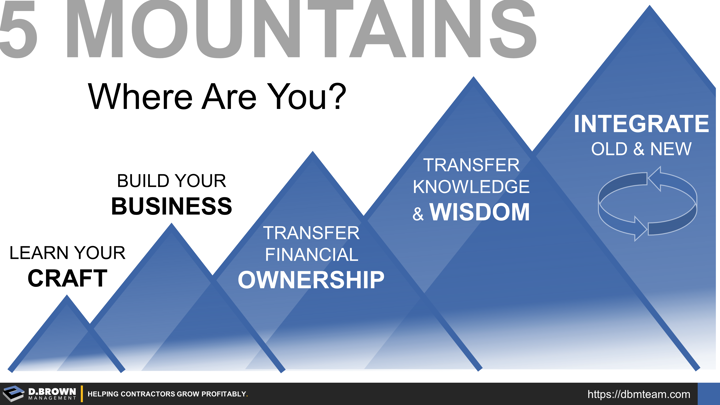This is overly simplified and not meant to convey every detail and is only meant to provide a basic map of a career and business over a 40–50-year cycle. The map is not the territory.
- Learn Your Craft: Whether your craft is an actual trade craft, engineering, construction management, accounting, or the many other technical functions required for a construction business, this is where we all start. This is the technical foundation that has enabled society to grow over the centuries. Whether your chosen craft(s) are newer like computer programming with a decades long history or thousands of years old like masonry, we are all benefiting from the lessons learned in prior generations.
- Building Your Business: At the core, a business is just a way of organizing groups of people with a wide variety of skills to do more than any one person can do alone. Every stage of growth brings both new opportunities and challenges. Whether you are the founder of the business, a 3rd generation CEO, or anyone in the management structure, you are helping build that business starting with the two basic management accountabilities. Growing the business requires an evolving leadership focus while never losing sight of the foundation.
- Transfer Financial Ownership: Eventually, this must occur for all businesses and individuals. This is an incredibly important mountain to climb but is too often thought of as a task rather than something integral to both building the business and the far more important latter two mountains. The financial transaction itself has complexity from tax codes to corporate law to financing. These are all very important and tangible details. Our recommendation is to look at it more like the architectural design phases of a project. Learn more with these series on Succession and Retirement Onboarding for Construction Contractors.
- Transfer Knowledge and Wisdom: This is far more important for the success of any financial ownership transition than any of the tax, structure, financing, or legal details. Every deal we've seen fall apart or fall short of the expected returns to all parties was because the critical knowledge and wisdom including values weren't effectively transferred.
- Integration of the Old and the New: This is the most valuable mountain to climb for making the next generation stronger. It requires that combination of deep experience, the ability to learn new things, and the wisdom to choose when to say something and when to let the next generation learn on their own through trial and error. Think about a 60-year-old crafts person and a 20-year-old apprentice. The current apprenticeship curriculum will be teaching both new things and teaching old things in new ways. The tools will be different. It is all evolution. On the jobsite, the 60-year-old will be able to learn new things, provide context for the reasons why some things have changed, and in some cases, help show that new isn't always better. That is what makes each generation better. This is the same in the field as it is in every aspect of the business.
Looking at all five of these mountains in the context of a business and integrating them systematically is what gets a contractor to Stages 6+ (S3) - Sustainable Scaling and Succession. This is Organizational Development and something that should be approached like learning any other craft once a contractor gets into stage 4 and beyond.
These five mountains have analogs in life as well as business. Learning the craft of being a parent, partner, adult child, etc. Building your family, friends, and community. Your charitable giving and what you set up for inheritance is the transfer of financial ownership. Just like in business, most importantly are the last couple mountains that truly make the next generation better.
Many people exploring the 4th and 5th mountains leverage industry associations, colleges, writing, and consulting. We would be happy to share our experiences with anyone exploring any of these mountains, especially the last two.
All relationships begin with a simple conversation - let's talk.

